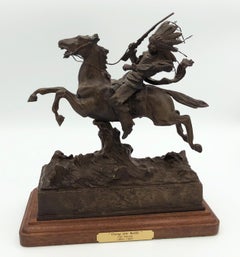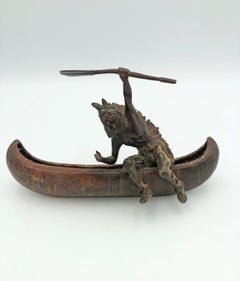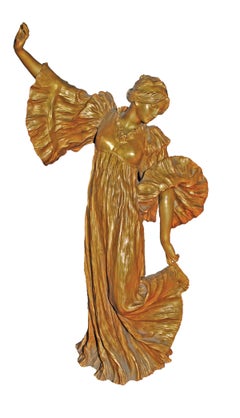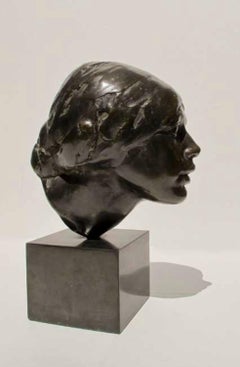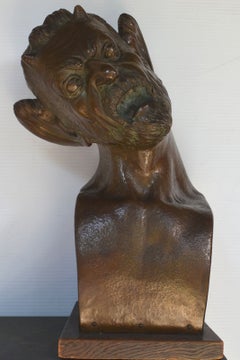Early 20th Century Figurative Sculptures
to
19
209
65
57
17
17
Overall Width
to
Overall Height
to
192
563
2,158
7,590
68
53
92
118
58
121
200
170
217
277
63
46
26
11
7
1
1
1
267
175
169
167
144
98
58
38
24
21
21
20
18
16
13
11
11
10
8
8
251
239
46
41
29
22
6
5
4
4
211
142
Period: Early 20th Century
Going into Battle
By Carl Kauba
Located in Missouri, MO
Carl Kauba
"Going into Battle" c. 1920s
Bronze with Brown Patina
Signed
approx 10 x 10 x 4 (including wooden base)
This Austrian sculptor was born in Vienna in 1865. His teachers were Karl Waschmann (1848-1905), known for his ivory sculptures and portrait plaquettes of contemporary celebrities, and Stefan Schwartz (1851-1924), who exhibited in Paris, including the Exposition Universelle of 1900 where he won a gold medal. Kauba's intricate bronzes, imported to the United States between 1895 and 1912, were cast at the Roman Bronze Works. Kauba was part of the nineteenth-century tradition of polychrome bronze sculpture. There were several types of patinas on a single statue: he could render the color of buckskin, variously tinted shirts, blankets, feathers, as well as beaded moccasins. Reportedly, Kauba came to America around 1886. Inspired by the Western tales of German author Karl May, he traveled to the West and made sketches and models. Critics, however, pointed out inaccuracies of costume and other details. For instance, the guns that his "mid-nineteenth-century" figures use are models produced after 1898. Apparently he did all of his works back in Vienna.
Besides the variety of color, Kauba's bronzes show a great range of textures and his style is highly naturalistic. The sculptor loved ornament, some of which he rendered with coiled wire for reins, rope and feathers in headdresses. He successfully rendered figures in motion and often executed compositions with more than one figure. Berman (1974) illustrates non-Western subjects by Kaula, such as the pendants Where? and There (ca. 1910), a seated Scottish couple, impressive in the expressions and the details on patterned fabrics of both sitters. Another genre piece is Buster Brown...
Category
Realist Early 20th Century Figurative Sculptures
Materials
Bronze
Price Upon Request
Native American in Canoe
By Carl Kauba
Located in Missouri, MO
Carl Kauba (1865-1922)
"Native American in Canoe"
Polychrome Bronze
Signed
approx 5.5 x 10 x 2.75 inches
This Austrian sculptor was born in Vienna in 1865. His teachers were Karl Waschmann (1848-1905), known for his ivory sculptures and portrait plaquettes of contemporary celebrities, and Stefan Schwartz (1851-1924), who exhibited in Paris, including the Exposition Universelle of 1900 where he won a gold medal. Kauba's intricate bronzes, imported to the United States between 1895 and 1912, were cast at the Roman Bronze Works. Kauba was part of the nineteenth-century tradition of polychrome bronze sculpture. There were several types of patinas on a single statue: he could render the color of buckskin, variously tinted shirts, blankets, feathers, as well as beaded moccasins. Reportedly, Kauba came to America around 1886. Inspired by the Western tales of German author Karl May, he traveled to the West and made sketches and models. Critics, however, pointed out inaccuracies of costume and other details. For instance, the guns that his "mid-nineteenth-century" figures use are models produced after 1898. Apparently he did all of his works back in Vienna.
Besides the variety of color, Kauba's bronzes show a great range of textures and his style is highly naturalistic. The sculptor loved ornament, some of which he rendered with coiled wire for reins, rope and feathers in headdresses. He successfully rendered figures in motion and often executed compositions with more than one figure. Berman (1974) illustrates non-Western subjects by Kaula, such as the pendants Where? and There (ca. 1910), a seated Scottish couple, impressive in the expressions and the details on patterned fabrics of both sitters. Another genre piece is Buster Brown...
Category
Realist Early 20th Century Figurative Sculptures
Materials
Bronze
Price Upon Request
La Cothurne
Located in Missouri, MO
"La Cothurne" 1901
Gilt Bronze
Approx 21.5" High (to raised hand)
Signed and Dated
Foundry Mark "Susse Freres"
Originally modeled in white biscuit porcelain this Greek dancer is a from a set of eight created for a dining table. They were immediately successful when they were exhibited in the Sevres pavilion at the 1900 Exhibition. Individual figures could be ordered and "La Cothurne" proved the most popular. Their success led to the firm of Susse buying the right to cast versions in metal.
Agathon Leonard (1841-1923) is one of the well-known French Art Nouveau sculptors. Born in Lille in 1841, he first studied there before moving to Paris where he studied at the Ecole des Beaux Arts under Eugene Delaplanche.
He gained recognition at the annual Expositiones Universelles, winning a Silver Medal there in 1889 and gold in 1900. His most important piece, Jeu L'echarpe, was the best known series of Sevres production at the turn of the century and sold out at the 1900 Expo in Paris and later was given as a gift by the French Gov't to Nicholas II at the Hermitage.
His bronzes were cast at the Susse Freres Editeurs Foundry. He worked also in marble, quartz and ivory. He also produced Art Nouveau medallions...
Category
Art Nouveau Early 20th Century Figurative Sculptures
Materials
Bronze
Price Upon Request
Nuska, Portrait of a Girl, unique bronze portrait by Isamu Noguchi 1924
By Isamu Noguchi
Located in Santa Fe, NM
Nuska, Portrait of a Girl, bronze portrait, 1924, unique
Isamu Noguchi (Japanese American 1904 - 1988); "Nuska, The Deaf Girl"; cire perdu cast bronze with complex dark patina on bronze base; 15 x lOx 8 inches; base 4.5 x 5.75 x 5,75 inches; signature quilled under and at back - "Isamu"; foundry stamp quilled in wax at the back - "Roman Bronze Works N.Y."
Excellent condition.
"Nuska, The Deaf Girl" is included in the Catalogue Raisonne of Noguchi's sculpture by Nancy Grove and Dianne Botnick (Garland, 1980) as Number 21. It is currently listed in the digital catalogue being assembled by the Isamu Noguchi Museum in Long Island City, New York as Number 10. This is apparently a unique casting, not part of an edition.
This is an apparently early, cire perdu bronze cast by Roman Bronze Works, probably when the foundry was located in the Louis Comfort Tiffany red...
Category
Contemporary Early 20th Century Figurative Sculptures
Materials
Bronze
Satyr
By Max Zeitz
Located in West Hollywood, CA
Presenting an early hand hammered copper sculpture, "Satyr", by Dutch artist Max Zeitz.
"Satyr", is an original, very early (1910) hand h...
Category
Early 20th Century Figurative Sculptures
Price Upon Request
